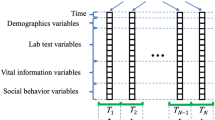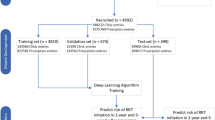Abstract
Kidney diseases (KD) are a global public health concern affecting millions. Early detection and prediction are crucial for effective treatment. Artificial intelligence (AI) techniques have been used in KDP to analyze past medical records, applying patients’ Electronic Medical Record (EHR) data. However, conventional statistical analysis methods conflict with fully comprehending the complexity of EHR data. AI algorithms have helped early KDP learn and identify complex data patterns. However, challenges include training heterogeneous historical data, protecting privacy and security, and developing monitoring system regulations. This study addresses the primary challenge of training heterogeneous datasets for real-world evaluation. Early detection and diagnosis of chronic kidney disease (CKD) is crucial for improved outcomes, reduced healthcare costs, and reliable treatment. Early treatments are crucial for CKD, as it often develops without apparent symptoms. Predictive models, particularly those using reinforcement learning (RL), can identify significant trends in complex healthcare information, which standard techniques may struggle with. The study makes KDP more accurate and reliable using RL methods on clinical data. This lets doctors find diseases earlier and treat them better by looking at static and changing health measurements. Machine learning (ML) algorithms can enhance the accuracy of AI systems over time, enhancing their effectiveness in detecting and diagnosing diseases. In the current investigation, the RL-ANN model is implemented for performing enforceable CKD by assessing the outcomes of multiple neural networks, which include FNN, RNN, and CNN, according to parameters such as accuracy, sensitivity, specificity, prediction error, prediction rate, and kidney failure rate (KFR). The recommended RL-ANN method has a lower failure rate of 70% based on the KFR data. Further, the proposed approach earned 95% in PR and 70% in analysis of errors. However, the RL-ANN approach obtained superior results of 97% accuracy, 95% sensitivity, and 90% specificity.









Similar content being viewed by others
Data Availability
Not applicable.
Code Availability
Not applicable.
References
Wu C, Zhou T, Tian Y, Wu J, Li J, Liu Z. A method for the early prediction of chronic diseases based on short sequential medical data. Artif Intell Med. 2022;127:102262.
Shanmugarajeshwari V, Ilayaraja M. intelligent prediction techniques for chronic kidney disease data analysis. Int J Artif Intell Mach Learn. 2021;2:19–37.
Xie G, Chen T, Li Y, Chen T, Li X, Liu Z. Artificial intelligence in nephrology: how can artificial intelligence augment nephrologists’ intelligence? Kidney Dis. 2019;1:1–6.
Mena Mamani N. Machine learning techniques and polygenic risk score application to prediction genetic diseases. Adv Distrib Comput Artif Intell J (ADCAIJ). 2020;9(1):5–14.
Ganie SM, Malik MB, Arif T. Early prediction of diabetes mellitus using various artificial intelligence techniques: a technological review. Int J Bus Intell Syst Eng. 2021;1(4):325.
Paul J, Bhukya R. Forty-five years of International Journal of Consumer Studies: A bibliometric review and directions for future research. Int J Consum Stud. 2021;45(5):937–63.
Sengan S, Khalaf OI, Vidya Sagar P, Sharma DK, Arokia Jesu Prabhu L, Hamad AA. Secured and privacy-based IDS for healthcare systems on e-medical data using machine learning approach. Int J Reliable Qual E-Healthc. 2022;11(3):1–11.
Sahu AK, Swain G. Reversible image steganography using dual-layer LSB matching. Sens Imaging. 2020. https://doi.org/10.1007/s11220-019-0262-y.
Saba SS, Sreelakshmi D, Sampath Kumar P, Sai Kumar K, Saba SR. Logistic regression machine learning algorithm on MRI brain image for fast and accurate diagnosis. Int J Sci Technol Res. 2020;9(3):7076–81.
Neal Joshua ES, Bhattacharyya D, Chakkravarthy M, Byun Y-C. 3D CNN with visual insights for early detection of lung cancer using gradient-weighted class activation. J Healthc Eng. 2021;2021:1–11.
Sridhar C, Pareek PK, Kalidoss R, Jamal SS, Shukla PK, Nuagah SJ. Optimal medical image size reduction model creation using recurrent neural network and GenPSOWVQ. J Healthc Eng. 2022;2022:1–8.
Banchhor C, Srinivasu N. Integrating cuckoo search-grey wolf optimization and correlative naive bayes classifier with map reduce model for big data classification. Data Knowl Eng. 2020;127:1017880.
Sengan S, Rao GRK, Khalaf OI, Babu MR. Markov mathematical analysis for comprehensive real-time data-driven in healthcare. Math Eng Sci Aerosp. 2021;12(1):77–94.
Talasila V, Madhubabu K, Mahadasyam MC, Atchala NJ, Kande LS. The prediction of diseases using rough set theory with recurrent neural network in big data analytics. Int J Intell Eng Syst. 2020;13(5):10–8.
Kumar V, et al. addressing binary classification over class imbalanced clinical datasets using computationally intelligent techniques. Healthcare (Switzerland). 2022;10(7):1293.
Sharma P, Moparthi NR, Namasudra S, Shanmuganathan V, Hsu C-H. Blockchain-based IoT architecture to secure healthcare system using identity-based encryption. Expert Syst. 2022. https://doi.org/10.1111/exsy.12915.
Gorla US, Rao K, Kulandaivelu US, Alavala RR, Panda SP. Lead finding from selected flavonoids with antiviral (Sars-cov-2) potentials against covid-19: an in-silico evaluation. Comb Chem High Throughput Screen. 2021;24(6):879–90.
Bandi V, Bhattacharyya D, Midhunchakkravarthy D. Prediction of brain stroke severity using machine learning. Revue d’Intelligence Artificielle. 2020;34(6):753–61.
Chithaluru P, Al-Turjman F, Stephan T, Kumar M, Mostarda L. Energy-efficient blockchain implementation for Cognitive Wireless Communication Networks (CWCNs). Energy Rep. 2021;7:8277–86.
Mubarakali A, Ashwin M, Mavaluru D, Kumar AD. Design an attribute-based health record protection algorithm for healthcare services in cloud environment. Multimed Tools Appl. 2020;79(5–6):3943–56.
Krishna BV, et al. Design and development of graphene FET biosensor for the detection of SARS-CoV-2. SILICON. 2022;14(11):5913–21.
Rao KS, et al. Design and sensitivity analysis of capacitive MEMS pressure sensor for blood pressure measurement. Microsyst Technol. 2020;26(8):2371–9.
Dharmadhikari SC, Gampala V, Rao CM, Khasim S, Jain S, Bhaskaran R. A smart grid incorporated with ML and IoT for a secure management system. Microprocess Microsyst. 2021;83:103954.
Rajendra Prasad K, Mohammed M, Noorullah RM. Visual topic models for healthcare data clustering. Evolut Intell. 2021;14(2):545–62.
Achanta SDM, Karthikeyan T, Kanna RV. Wearable sensor-based acoustic gait analysis using phase transition-based optimization algorithm on IoT. Int J Speech Technol. 2021. https://doi.org/10.1007/s10772-021-09893-1.
Thota MK, Shajin FH, Rajesh P. Survey on software defect prediction techniques. Int J Appl Sci Eng. 2020;17(4):331–44.
Hira S, Bai A, Hira S. An automatic approach based on CNN architecture to detect Covid-19 disease from chest X-ray images. Appl Intell. 2021;51(5):2864–89.
Ramesh KKD, Kiran Kumar G, Swapna K, Datta D, Suman Rajesh S. A review of medical image segmentation algorithms. EAI Endorsed Trans Pervasive Health Technol. 2021;7(27):e6.
Naik A, Satapathy SC, Abraham A. Modified Social Group Optimization—a meta-heuristic algorithm to solve short-term hydrothermal scheduling. Appl Soft Comput J. 2020;95:106524.
Kumar EK, Kishore PVV, Kiran Kumar MT, Kumar DA. 3D sign language recognition with joint distance and angular coded color topographical descriptor on a 2—stream CNN. Neurocomputing. 2020;372:40–54.
Kumar S, Jain A, Kumar Agarwal A, Rani S, Ghimire A. Object-based image retrieval using the U-net-based neural network. Comput Intell Neurosci. 2021;2021:1–14.
Sengan S, Vidya Sagar P, Ramesh R, Khalaf OI, Dhanapal R. The optimization of reconfigured real-time datasets for improving classification performance of machine learning algorithms. Math Eng Sci Aerosp. 2021;12(1):43–54.
Routray S, Malla PP, Sharma SK, Panda SK, Palai G. A new image denoising framework using bilateral filtering based non-subsampled Shearlet transform. Optik. 2020;216:164903.
Reddy AVN, Krishna CP, Mallick PK. An image classification framework exploring the capabilities of extreme learning machines and artificial bee colony. Neural Comput Appl. 2020;32(8):3079–99.
Eali SNJ, Bhattacharyya D, Nakka TR, Hong S-P. A novel approach in bio-medical image segmentation for analyzing brain cancer images with U-NET semantic segmentation and TPLD models using SVM. Traitement du Signal. 2022;39(2):419–30.
Mandhala VN, Bhattacharyya D, Vamsi B, Thirupathi Rao N. Object detection using machine learning for visually impaired people. Int J Curr Res Rev. 2020;12(20):157–67.
Mohammed M, Kolapalli R, Golla N, Maturi SS. Prediction of rainfall using machine learning techniques. Int J Sci Technol Res. 2020;9(1):3236–40.
Ganesan V, Sobhana M, Anuradha G, Yellamma P, Devi OR, Prakash KB, Naren J. Quantum inspired meta-heuristic approach for optimization of genetic algorithm. Comput Electr Eng. 2021;94:107356.
Prakash KB. Quantum meta-heuristics and applications, cognitive engineering for next generation computing: a practical analytical approach. 2021. p. 265–297.
Ismail M, Prakash KB, Rao MN. Collaborative filtering-based recommendation of online social voting. Int J Eng Technol (UAE). 2018;7(3):1504–7.
Prakash KB. Information extraction in current Indian web documents. Int J Eng Technol (UAE). 2018;7(2):68–71.
Prakash KB. Content extraction studies using total distance algorithm. In: Proceedings of 2nd international conference on applied and theoretical computing and communication technology, no. 7912085. 2017. p. 673–9.
Prakash KB, Rangaswamy MAD. Content extraction of biological datasets using soft computing techniques. J Med Imaging Health Inform. 2016;6(4):932–6.
Prakash KB, Rajaraman A. Mining of bilingual indian web documents. Procedia Comput Sci. 2016;89:514–20.
Prakash KB, Dorai Rangaswamy MA. Content extraction studies using neural network and attribute generation. Indian J Sci Technol. 2016;9(22):1–10.
Prakash KB. Mining issues in traditional Indian web documents. Indian J Sci Technol. 2015;8(32):1–11.
Prakash KB, Dorai Rangaswamy MA, Ananthan TV, Rajavarman VN. Information extraction in unstructured multilingual web documents. Indian J Sci Technol. 2015;8:16.
Prakash KB, Rangaswamy MAD, Raja Raman A. ANN for multi-lingual regional web communication. In: Lecture Notes in Computer Science (including subseries Lecture Notes in Artificial Intelligence and Lecture Notes in Bioinformatics), 7667 LNCS (PART 5). 2012. p. 473–8.
Prakash KB, Rangaswamy MAD, Raman AR. Statistical interpretation for mining hybrid regional web documents. Commun Comput Inf Sci (CCIS). 2012;292:503–12.
Kolla BP, Dorairangaswamy MA, Rajaraman A. A neuron model for documents containing multilingual Indian texts. In: International Conference on Computer and Communication Technology, ICCCT-2010, art. no. 5640489. 2010. p. 451–4.
Prakash KB, Dorai Rangaswamy MA, Raman AR. Text studies towards multi-lingual content mining for web communication. In: Proceedings of the 2nd International Conference on Trendz in Information Sciences and Computing, TISC-2010, no. 5714601. 2010. p. 28–31.
Jaiprakash SP, Desai MB, Prakash CS, Mistry VH, Radadiya KL. Low dimensional DCT and DWT feature-based model for detection of image splicing and copy-move forgery. Multimed Tools Appl. 2020;79(39–40):29977–30005.
Rachapudi V, Talapaneni CH, Kolluri D, Akthar AN, Anjali Devi S. Improved convolutional neural network for classification of white blood cells. Int J Control Autom. 2020;13(2):883–8.
Srinivas M, Pavan Kumar T, Sai Vivek U, Bala Narasimha Rao R, Avinash A. Exploratory study for data visualization on Internet of things. J Adv Res Dyn Control Syst. 2020;12(2):2286–97.
Doppala BP, Midhunchakkravarthy, Bhattacharyya D. Premature detection of cardiomegaly using hybrid machine learning technique. J Adv Res Dyn Control Syst. 2020;12(6):490–8.
Mandhala VN, Somesekhar G, Kumar GA. Image classification using advanced convolutional neural networks (Acnn). J Adv Res Dyn Control Syst. 2020;12(6):632–6.
Sai Sudha G, Praveena M, Sandhya Rani G, Harish TNSK, Charisma A, Asish A. Classification and detection of diabetic retinopathy using deep learning. Int J Sci Technol Res. 2020;9(4):3186–92.
https://archive.ics.uci.edu/dataset/336/chronic+kidney+disease.
Funding
Not applicable.
Author information
Authors and Affiliations
Corresponding authors
Ethics declarations
Conflict of interest
Not applicable.
Additional information
Publisher's Note
Springer Nature remains neutral with regard to jurisdictional claims in published maps and institutional affiliations.
This article is part of the topical collection “Machine Learning for Pandemic Prediction and Control” guest edited by Anand J Kulkarni, Akash Tayal, Patrick Siarry, Arun Solanki and Ali Husseinzadeh Kashan.
Rights and permissions
Springer Nature or its licensor (e.g. a society or other partner) holds exclusive rights to this article under a publishing agreement with the author(s) or other rightsholder(s); author self-archiving of the accepted manuscript version of this article is solely governed by the terms of such publishing agreement and applicable law.
About this article
Cite this article
Nramban Kannan, S., Aseervatham, J., Moholkar, K. et al. A Model for Predicting Chronic Kidney Diseases Based on Medical Data Using Reinforcement Learning. SN COMPUT. SCI. 5, 353 (2024). https://doi.org/10.1007/s42979-024-02665-z
Received:
Accepted:
Published:
DOI: https://doi.org/10.1007/s42979-024-02665-z




